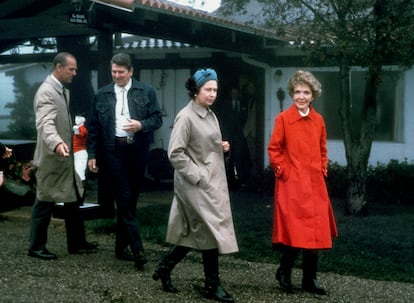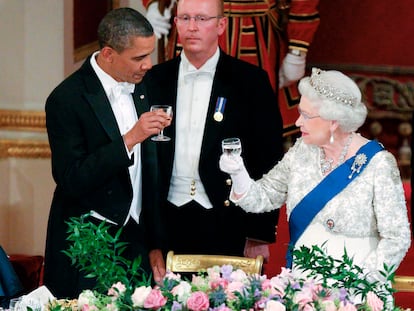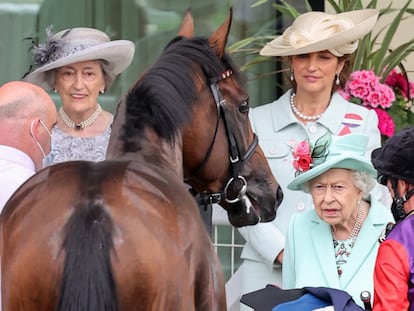FBI reveals death threat against Queen Elizabeth II during her visit to the US in 1983
An IRA sympathizer expressed his intention to assassinate the British monarch when she arrived in the city of San Francisco. The man, who remains unnamed, claimed that the security forces had killed his daughter in Northern Ireland with a rubber bullet

This past week, the FBI published several internal documents which were previously unavailable to the public. These reports revealed a threat to attack Queen Elizabeth and her husband, Prince Philip, the Duke of Edinburgh, during their official visit to the United States in 1983.
On its website, The Vault, the agency has posted 102 pages of information, after various media outlets requested it through the Freedom of Information Act. According to these records, U.S. authorities were especially alert about the possibility that the Irish Republican Army (IRA) terrorist organization might try to attack the British monarch while she was on American soil. At its peak, the IRA had thousands of supporters in the United States.
According to the documents, in a San Francisco bar — which was regularly frequented by supporters of Irish republicanism — a man approached a plainclothes police officer. Over drinks, he told him that his daughter had been killed by a rubber bullet in Northern Ireland, which had been fired by a member of the security forces. This had apparently occurred during the Troubles — a euphemism for the sectarian violence that plagued Northern Ireland for decades. The conversation took place on February 4, 1983, a month before the queen’s scheduled state visit to California.
The man, according to what the officer told the FBI, wanted to take his revenge with some kind of action against the British monarch and her husband. “This man claimed that he was going to attempt to harm Queen Elizabeth and would do this either by dropping some object off the Golden Gate Bridge (which links the San Francisco Peninsula to Marin County to the north) onto the royal yacht Britannia (which the queen was using for her travels)... [or he would] attempt to kill Queen Elizabeth when she visited Yosemite National Park,” reads one of the documents. According to the new information, the FBI took the threat seriously enough to plan to close pedestrian access to the bridge when the yacht was about to pass under it.
However, it’s unclear if this preventative measure was actually carried out, nor do the documents disclose what precautions (if any) were taken in Yosemite, where the queen and her husband ended up visiting as planned.
The constant threat of the IRA
The tension that Northern Ireland was experiencing during the 1980s put the IRA on the radar of Western security services. The enormous number of supporters of the group in the United States made Washington focus its security measures on this threat, especially during each official visit by Elizabeth II. More than 30 million Americans claim Irish ancestry, while the island’s population is barely seven million.
During the United States Bicentennial celebrations of 1976, Elizabeth II visited New York City. The documents revealed by the FBI say that a pilot was officially summoned to appear before a judge, after he flew over Battery Park in southern Manhattan with a huge banner that said “England, get out of Ireland.”
During Elizabeth II’s regular visits to the state of Kentucky, to learn first-hand about the methods of breeding and training racehorses — her beloved hobby — the American authorities went on alert. One of the FBI documents notes that, in 1989, in the days leading up to one of those visits, “the possibility of threats against [the British monarchy] by the Irish Republican Army was ever-present.” On that occasion, a memo was issued that warned FBI agents in Boston and New York to remain especially “alert for any threats” from members of the IRA against Elizabeth II. Additional security was also requested for the Kentucky Derby in Louisville, where the queen would watch the famous horse race.
In 1991, the queen was scheduled to attend a Baltimore Orioles baseball game with then-President George H. W. Bush. The FBI warned of potential danger based on an article that was published in Irish Edition, a Philadelphia monthly covering all things Irish. “The article stated [that] anti-British feelings are running high as a result of well-publicized injustices inflicted on the Birmingham Six (six individuals convicted of bombing a Birmingham pub in 1974, whose sentences were later overturned) by the corrupt English judicial system and the recent rash of brutal murders of unarmed Irish nationalists in six [Northern Ireland] counties by loyalist death squads.” The article also warned that a group of Irishmen had reserved a large number of seats at the baseball stadium where, the FBI suspected, they would try to protest the British crown.
At the start of 1973, the IRA decided to extend its campaign of attacks — which had, until that point, been concentrated in Belfast and Londonderry — to England. The biggest blow against the British monarchy occurred on August 27, 1979, when the terrorist organization assassinated Louis Mountbatten by blowing up the boat he was travelling in, in County Sligo, Republic of Ireland. Mountbatten — the last viceroy of India, a distant cousin of Elizabeth II and unofficial guardian of her son, Charles, the then-Prince of Wales — died instantly, along with his 14-year-old grandson Nicholas Knatchbull and Paul Maxwell, a 15-year-old boy who had been assisting the crew.
Sign up for our weekly newsletter to get more English-language news coverage from EL PAÍS USA Edition
Tu suscripción se está usando en otro dispositivo
¿Quieres añadir otro usuario a tu suscripción?
Si continúas leyendo en este dispositivo, no se podrá leer en el otro.
FlechaTu suscripción se está usando en otro dispositivo y solo puedes acceder a EL PAÍS desde un dispositivo a la vez.
Si quieres compartir tu cuenta, cambia tu suscripción a la modalidad Premium, así podrás añadir otro usuario. Cada uno accederá con su propia cuenta de email, lo que os permitirá personalizar vuestra experiencia en EL PAÍS.
¿Tienes una suscripción de empresa? Accede aquí para contratar más cuentas.
En el caso de no saber quién está usando tu cuenta, te recomendamos cambiar tu contraseña aquí.
Si decides continuar compartiendo tu cuenta, este mensaje se mostrará en tu dispositivo y en el de la otra persona que está usando tu cuenta de forma indefinida, afectando a tu experiencia de lectura. Puedes consultar aquí los términos y condiciones de la suscripción digital.
More information
Archived In
Últimas noticias
There is as much life left to discover on planet Earth as that which is already known
Dozens presumed dead, around 100 injured in fire at Swiss Alps bar during New Year’s celebration
Is porn for women different from conventional porn? We spoke to those who make it
Cartagena de Indias is sinking: What can the city do to mitigate it?
Most viewed
- Sinaloa Cartel war is taking its toll on Los Chapitos
- Reinhard Genzel, Nobel laureate in physics: ‘One-minute videos will never give you the truth’
- David King, chemist: ‘There are scientists studying how to cool the planet; nobody should stop these experiments from happening’
- Oona Chaplin: ‘I told James Cameron that I was living in a treehouse and starting a permaculture project with a friend’
- The Interoceanic Train, the Mexican alternative to the Panama Canal











































